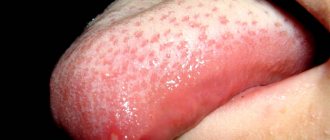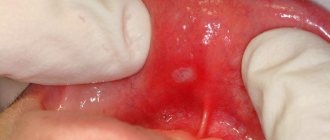- home
- Diseases
- Stomatitis
- Chronic stomatitis
Chronic stomatitis is a disease that is accompanied by repeated inflammatory processes of the oral mucosa. Many patients want to know what causes the development of chronic stomatitis. In the vast majority of cases, the development of this pathological condition is associated with a whole complex of various factors - both internal and external.
The most common form today is chronic aphthous stomatitis, which is diagnosed in 5% of cases among all diseases of the oral mucosa.
In our clinic you can get a free dental consultation!
Our doctors
18 years of experience
Baghdasaryan
Armen Evgenievich
Chief physician, dentist-orthopedist-therapist
Graduated from VSMA named after. N.N. Burdenko. Internship on the basis of MGMSU named after. A.E. Evdokimov in “General Dentistry”.
Clinical residency at the Moscow State Medical University named after. A.E. Evdokimov in “Orthopedics”.
More about the doctor...
5 years experience
Sadina
Ekaterina Vladislavovna
Dental therapist, surgeon
Penza State University Medical Institute, specialty “Dentistry”.
In 2016, she underwent professional retraining in the specialty “Therapeutic Dentistry” at the Moscow State Medical and Dental University named after A.I. Evdokimov.
More about the doctor...
8 years of experience
Arzumanov
Andranik Arkadievich
Dentist-orthodontist
Graduated from Moscow State Medical University. Internship - Moscow State Medical University at the Department of Orthodontics and Children's Prosthetics.
Residency at Moscow State Medical University at the Department of Orthodontics and Children's Prosthetics. Member of the Professional Society of Orthodontists of Russia since 2010.
More about the doctor...
Causes
It is customary to identify various causes of chronic stomatitis in adults. They determine the form of the disease:
- The aphthous form can be caused by E. coli, streptococci, or a bacterial allergic reaction. There is a connection with autoimmune pathologies, as well as disruptions in the gastrointestinal tract and endocrine system;
- The candidiasis form develops with long-term use of antibacterial agents when infected with fungi of the genus Candida;
- The herpes form occurs due to the presence of the herpes simplex virus in the body with decreased immunity;
- Prosthetic chronic stomatitis in adults can be caused by various factors: an allergic reaction to the components from which the prosthesis is made; insufficiently good hygiene of dentures; frequent damage to the mucous membrane due to improperly fitted, installed or faulty dentures;
- Vincent's stomatitis can be provoked by spindle-shaped bacillus and Vincent's spirochete against the background of decreased immunity.
We cannot ignore the factors that provoke the development of chronic recurrent stomatitis. These include:
- unbalanced diet;
- taking medications;
- frequent stress;
- acute respiratory diseases;
- hypothermia;
- vitamin deficiency;
- irregular and insufficiently good oral hygiene;
- advanced stages of caries;
- ear, nose and throat infections.
Treatment at home and folk remedies
As an addition to the main therapy, it is possible to use folk remedies. Ginseng, propolis and echinacea are considered good immunomodulators. Infusions of chamomile, propolis or oak bark help cope with inflammation; aloe and sea buckthorn oil promote healing of aphthae. In any case, it is unlikely that you will be able to get rid of the disease using folk remedies alone, so do not delay in visiting a doctor. Timely therapy helps cure aphthous stomatitis and eliminate its symptoms within two weeks. Advanced stages are much more difficult to respond to and can cause irreversible deformation of soft tissues.
Attention!
Conservative therapy implies the possibility of treatment at home, but a visit to a doctor is still necessary, since only a specialist can draw up an optimal rehabilitation plan (including prescribing an ointment, solution, antibiotics, anti-inflammatory drugs, etc.) and track intermediate results.
Clinical manifestations
The symptoms of chronic stomatitis directly depend on the form of the disease
| Type of acute stomatitis | Clinical manifestations |
| Atrophic |
|
| Vincent |
|
| Herpetic |
|
| Prosthetic |
|
How to treat aphthous stomatitis
Treatment of aphthous stomatitis is the job of a qualified specialist. Self-medication is not worth it because even for a professional it is not always easy to establish the true cause of the onset and exacerbation of the disease. In general, treatment is carried out according to the following method:
- the use of medications against the ulcers themselves and to prolong remissions and prevent relapses
- the use of painkillers and necrolytic agents (to remove dead diseased tissue)
- treatment with antiseptic, anti-inflammatory and healing drugs
- referral for examination to identify concomitant and provoking diseases
- drawing up a dietary diet (necessarily excluding hot, spicy and rough foods, as well as allergens).
Aphthous stomatitis occurs not only in adults, but also in children. Moreover, the method of its treatment in children does not differ from procedures in adults. The children's diet is additionally enriched with sources of vitamins B and C, and immunostimulating drugs are prescribed.
Diagnostics
The most important role in diagnosing a disease is to establish the causes of its development. It is they who determine the future tactics of treating inflammatory processes. In order to achieve the desired result, make a smear from the surface of the ulcer, and also carry out:
- study of ulcerative lesions;
- bacteriological examination;
- checking the plasma chain reaction of scrapings.
Treatment
In order to eliminate chronic stomatitis, professional oral hygiene, sanitation of infectious foci and local applications are carried out. As for the specific tactics used for one form or another of the disease, they are presented in the table below
| Type of acute stomatitis | Treatment options |
| Vincent |
|
| Herpetic |
|
| Traumatic |
|
Forms of stomatitis
The general word “stomatitis” refers to inflammation, which can have a different course and arise for various reasons. There are several types of disease:
- Catarrhal.
- Aphthous.
- Candida.
- Herpetic (or herpes).
- Allergic.
Catarrhal
The catarrhal form of stomatitis is the most common; it is characterized by pain and hyperemia of the mucous membrane. Its color changes, becoming more red. Often its surface is covered with a whitish or yellowish coating. Your gums may bleed and your mouth may smell bad.
Aphthous
The aphthous form of stomatitis often becomes chronic, then it begins to appear regularly - several times a year. When it occurs, small ulcers covered with plaque are formed on the mucous membrane - aphthae. Usually, aphtha “warns” of itself by redness, burning and a slight bulge at the site of its future appearance. The erosions themselves are light in color with a red edge; when you press on them, pain is felt. In mild cases, only 1-2 erosions may occur, which disappear within a week. In severe cases, there are much more rashes, healing is more difficult and scars may remain in place of the aphthae.
Candida
Fungi of the genus Candida “love” to settle on mucous membranes, including the oral cavity. This often happens after long-term use of antibiotics, due to disruption of microflora and decreased immunity. The result is candidal stomatitis, which is manifested by burning of the mucous membrane, its redness, and the presence of a whitish coating in the mouth. Often these symptoms are accompanied by a feeling of unpleasant taste, or even loss of taste. Stomatitis often occurs in newborns who are still feeding on milk, and in adults who constantly use removable dentures .
Herpetic (or herpes)
Herpetic stomatitis is similar to aphthous stomatitis. It is also characterized by the appearance of light-colored ulcers with a red border and a film on top. And it can also appear periodically, since the herpes virus - its cause - remains in the body without being completely eliminated from it. At the very beginning of the disease, the mucous membrane acquires
red color and becomes very sensitive. Normal impacts on it can cause pain. The difference between aphthous and herpes stomatitis is that during the latter, vesicles 3–5 mm in size appear, which break through and form erosions. This process is very painful. The number of such bubbles depends on the severity of the disease. In severe cases, the temperature often rises.
Allergic
Allergic stomatitis is manifested by noticeable swelling of the mucous membrane, profuse salivation and itching in the mouth. Such stomatitis in children can occur when a new product appears in the diet, then the itching is especially intensified after eating. In older age, the cause is often a decrease in immunity.
In all of these forms, stomatitis begins with redness and increased sensitivity of the mucous membrane. At this stage, you cannot independently determine what the further development of the disease will be. Therefore, if the gums become red, enlarged, and begin to react painfully to food and even brushing, this is already a reason to consult a dentist. An experienced doctor will be able to determine the type of disease after examining and talking with the patient.
Where to contact?
You can get treatment for chronic stomatitis at the Good Hands dental clinic. Our specialists are well aware that frequent relapses of the disease can reduce the patient’s quality of life and can provoke the development of periodontitis and benign and malignant oral tumors. They use individual treatment tactics that allow you to achieve good results, make the treatment effective and painless. You can schedule a free consultation with us and find out all the necessary information right now by filling out an application on our website or calling us by phone.
Course of the disease
Acute aphthous stomatitis often begins acutely and often against the background of an acute respiratory infection or sore throat1. Body temperature rises, lethargy, weakness, headache, and muscle aches appear8. Against this background, single or multiple aphthae appear on the oral mucosa8, salivation sharply increases, and bad breath appears1. The number of aphthae and their depth and healing time depend on the severity of the disease1.
Chronic aphthous stomatitis can occur in mild or severe forms1,3,4, which can be determined by a dentist.
Up to contents











